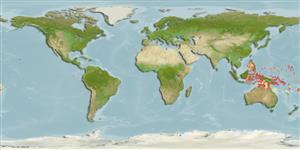>
Eupercaria/misc (Various families in series Eupercaria) >
Nemipteridae (Threadfin breams, Whiptail breams)
Etymology: Scolopsis: Greek, skolex = worm + Greek, opsis = appearance (Ref. 45335).
More on author: Cuvier.
Environment: milieu / climate zone / depth range / distribution range
Ökologie
seewasser riff-verbunden; tiefenbereich ? - 35 m (Ref. 90102). Tropical; 19°N - 23°S, 115°E - 176°W
Western Pacific: Eastern Indonesia, Solomon Islands, Santa Cruz Islands and Fiji. This species closely resembles Scolopsis monogramma, and the two species have been previously confused.
Size / Gewicht / Alter
Maturity: Lm ? range ? - ? cm
Max length : 35.0 cm SL Männchen/unbestimmt; (Ref. 48635); common length : 20.0 cm SL Männchen/unbestimmt; (Ref. 3810)
Rückenflossenstacheln (insgesamt): 10; Rückenflossenweichstrahlen (insgesamt): 9; Afterflossenstacheln 3; Afterflossenweichstrahlen: 7. Head scales reaching forward to or just behind level of anterior margin of eye. A small naked area on temporal region behind eye. Lower limb of preopercle scaly. Antrorse (forward-directed) suborbital spine absent. Pelvic fins long, reaching to or beyond level of anus. Upper lobe of caudal fin a little longer then lower lobe. Lobes produced to form filamentous extensions in larger specimens. Color: Upper body bluish, white below. Sides are also bluish. Scales on body with yellow centers forming horizontal lines above lateral line and diagonal lines below. A pinkish-brown stripe from behind eye, arching on back beneath lateral line and terminating behind tip of pectoral fin. Four blue stripes on head.
Inhabits coastal and lagoon waters, on sand rubble bottoms close to reefs. Usually seen solitary in 20+ m depth. May also be seen in groups. (Ref. 48635, 90102)
Life cycle and mating behavior
Geschlechtsreife | Fortpflanzung | Ablaichen | Eier | Fecundity | Larven
Russell, B.C., 1990. FAO Species Catalogue. Vol. 12. Nemipterid fishes of the world. (Threadfin breams, whiptail breams, monocle breams, dwarf monocle breams, and coral breams). Family Nemipteridae. An annotated and illustrated catalogue of nemipterid species known to date. FAO Fish. Synop. 125(12):149p. Rome: FAO. (Ref. 3810)
IUCN Rote Liste Status (Ref. 130435)
Bedrohung für Menschen
Harmless
Nutzung durch Menschen
Fischereien: kleinfischerei
Mehr Information
NamenSynonymeMetabolismusRäuberÖkotoxikologieFortpflanzungGeschlechtsreifeAblaichenSpawning aggregationFecundityEierEientwicklung
ReferenzenAquakulturAquakultur ProfilZuchtlinienGenetikElectrophoresesVererbbarkeitKrankheitenVerarbeitungNutrientsMass conversion
PartnerBilderStamps, Coins Misc.LauteCiguateraGeschwindigkeitSchwimmstilKiemenoberflächeOtolithsGehirngrößeSehfähigkeit
Tools
Zusatzinformationen
Download XML
Internet Quellen
Estimates based on models
Preferred temperature (Ref.
123201): 27.3 - 29.3, mean 28.8 °C (based on 1018 cells).
Phylogenetic diversity index (Ref.
82804): PD
50 = 0.5000 [Uniqueness, from 0.5 = low to 2.0 = high].
Bayesian length-weight: a=0.01514 (0.00838 - 0.02734), b=2.96 (2.81 - 3.11), in cm total length, based on LWR estimates for this species & Genus-body shape (Ref.
93245).
Trophic level (Ref.
69278): 3.5 ±0.37 se; based on food items.
Widerstandsfähigkeit (Ref.
120179): mittel, Verdopplung der Population dauert 1,4 - 4,4 Jahre. (Preliminary K or Fecundity.).
Fishing Vulnerability (Ref.
59153): Low to moderate vulnerability (33 of 100).
Nutrients (Ref.
124155): Calcium = 47.9 [29.8, 94.0] mg/100g; Iron = 0.597 [0.298, 1.473] mg/100g; Protein = 19 [17, 21] %; Omega3 = 0.139 [0.084, 0.230] g/100g; Selenium = 28.6 [17.2, 50.0] μg/100g; VitaminA = 75.2 [21.1, 210.5] μg/100g; Zinc = 1.21 [0.85, 1.73] mg/100g (wet weight);
